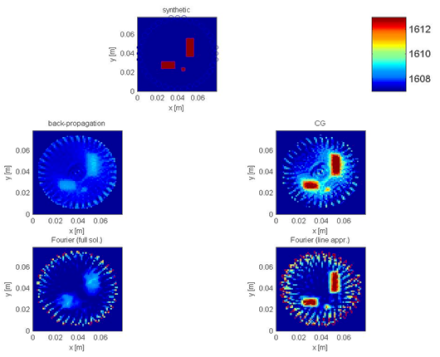Low frequency imaging
Low Frequency Ultrasonic Imaging
Research completed at the Ultrasonics Research Group was carried out to assess the feasibility of using non-invasive low-frequency ultrasound and new imaging methods to accurately estimate the temperature distribution in and around a tumour during hyperthermia cancer treatments such as high intensity focused ultrasound (HIFU). In such treatments, the temperature of the tumour is elevated to destroy the cancerous cells; accurate and non-invasive monitoring of the temperature and thermal dose is critical to avoid excess damage to surrounding healthy tissue. Previous methods of temperature estimation using ultrasound have relied on using the backscattered signals only, as this simplifies the data acquisition and the reconstruction mathematics. This project investigated using both through-transmitted and scattered ultrasonic energy to make a non-invasive estimation of tissue temperature using novel imaging methods, as some acoustic properties such as the speed of sound in tissue are temperature dependent.

The main objective was to develop and assess suitable imaging algorithms. First, an accurate computer model of a heated region in liver tissue was formulated, and used to generate synthetic ultrasonic data for testing. The model computed the propagation and scattering of low-frequency (<320kHz) acoustic pressure and velocity fields by solving the acoustic wave equations using a conjugate gradient (CG) technique in the temporal Laplace domain. This artificial data was then used to assess two different types of imaging methods for reconstructing the speed of sound profiles (and hence tissue temperature); Fourier methods based on straight ray theory, and inversion methods for integral equations derived from the acoustic wave equations. The research showed that with the synthetic data, the Fourier methods were not able to accurately localise the heated regions and reconstruct the sound speed using the low-frequency ultrasonic signals, although the techniques were relatively easy to implement and computationally efficient. The novel integral equation based methods gave much more accurate images, since they could take effects like scattering and diffraction into account. These methods were able to accurately localise and reconstruct the speed of sound contrasts using the low-frequency synthetic data.
Relevant publications:
- K. W. A. van Dongen and W. M. D. Wright, "A full vectorial Contrast Source inversion scheme for 3D acoustic imaging of both compressibility and density profiles", J. Acoust. Soc. Am., Vol. 121, No. 3, pp. 1538-1549 (2007)
- K. W. A. van Dongen and W. M. D. Wright, "A forward model and conjugate gradient inversion technique for low-frequency ultrasonic imaging", J. Acoust. Soc. Am., Vol. 120, No. 4, pp. 2086-2095 (2006)
- K. W. A. van Dongen and W. M. D. Wright, "A Contrast Source Inversion Scheme for Imaging Acoustic Contrast", Proc. IEE Irish Signals and Systems Conference 2005, Dublin, Ireland, September 1st - 2nd 2005, pp. 278-283 (2005)
- K. W. A. van Dongen, C. Brennan and W. M. D. Wright, "A Reduced Forward Operator for Acoustic Scattering Problems", Proc. IEE Irish Signals and Systems Conference 2005, Dublin, Ireland, September 1st - 2nd 2005, pp. 294-299 (2005)
